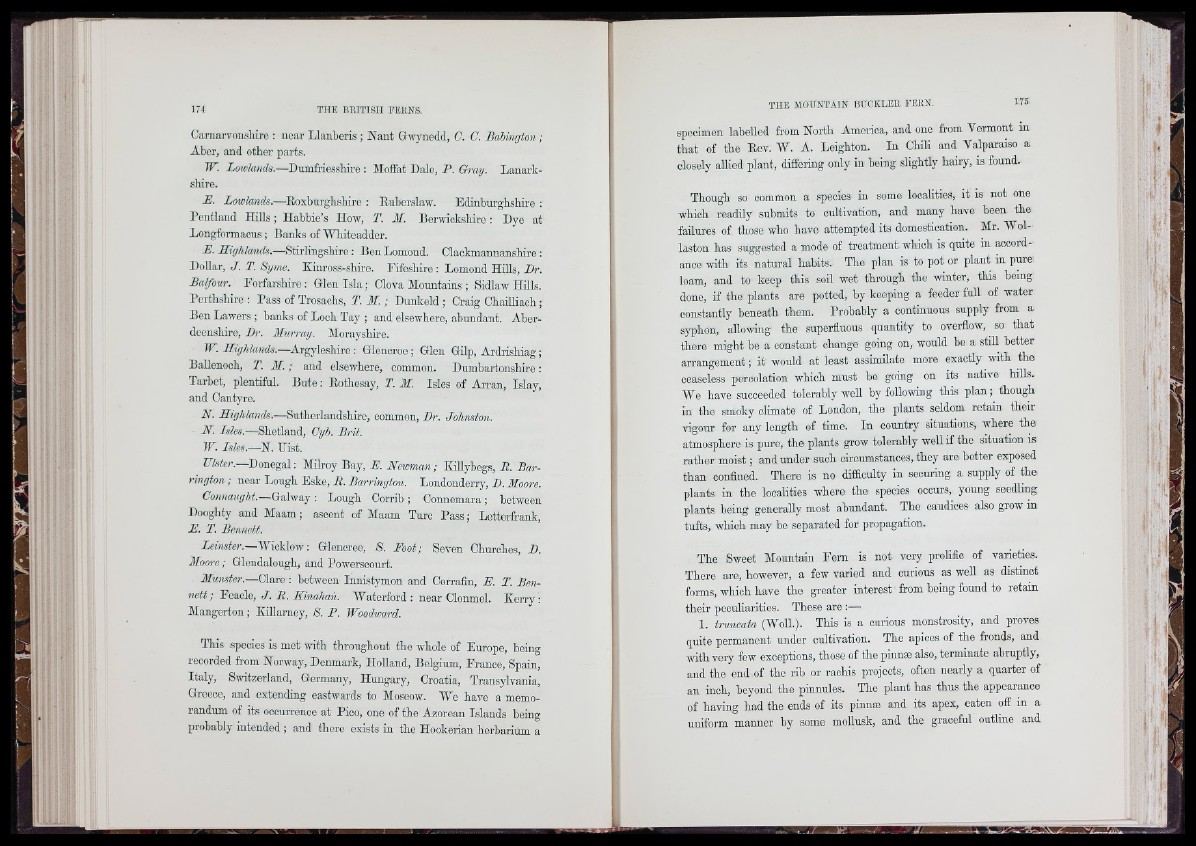
CarnarTOiisliire : near Llanheris ; Nant Gwynedd, C. C. Babington ;
Aher, and other parts.
W. Lowlands.—Dumfriesshire : Moffat Dale, P . Onaj. Lanarkshire.
E. Lowlands.—Roxburghshire : Euherslaw. Edinburghshire :
Eentland H ills ; Hahbie’s How, T. M. Berwickshire; Dye at
Longformacus; Banks of Whitoadder.
E. Highlands.—Stirlingshire: Ben Lomond. Clackmannanshire;
Eddar, J . T. Sgme. Kinross-shiro. Fifeshire; Lomond Hills, P r .
Balfour. Forfarshire: Glen Is la ; Clova Mountains ; Sidlaw Hills.
Perthshire: Pass of Trosaohs, T. M . ; Dunkeld; Craig Chailliaoh;
Bon Lawers ; hanks of Looh Tay ; and elsewhere, abundant. Aberdeenshire,
Dr. Murray. Morayshire.
W. Highlands.—^Argylcshire: Glencroe; Glen Gilp, Ardrishiag;
Ballenooh, T. M . ; and elsewhere, common. Dumbartonshire:
Tarhet, plentiful. B u te ; Rothesay, T. M. Isles of Arran, Islay,
and Cantyre.
N. Highlands.—Sutherlandshire, common. Dr. Johnston.
N. Isles.—Shetland, Cxjh. Brit.
W. Isles.— Hist.
Ulster.—Donegal; Milroy Bay, E. Netvman; KiUybegs, P . Barrington
; noar Lough Eske, R. Barrington. Londonderry, D. Moore.
Connaught. Galway; Lough Corrib; Connemara; between
Dooghty and Maam; ascent of Maam Turo P a s s ; Letterfrank,
E. T. Bennett.
Leinster.—^Ymk\ow. Glencree, 8. Foot; Seven Churches, D.
Moore; Glendalough, and Powersoourt.
Munster.— Glare : between Innistymon and Corrafin, E. T. Bennett;
Feade, J . R . Kinahan. Waterford; near Clonmel. Kerry;
Mangerton; Killarney, 8. P . Woodtoard.
This species is met with throughout the whole of Europe, being
recorded from Norway, Denmark, Holland, Belgi um, France, Spain,
Italy, Switzerland, Germany, Hungary, Croatia, Transylvania,
Greece, and extending eastwards to Moscow. We have a memorandum
of its occurrence at Pico, one of the Azorean Islands being
probably intended ; and there exists in tho Hookerian herbarium a
specimen labelled from North America, and one from Vermont in
that of the Eev. W. A. Leighton. In Chili and Valparaiso a
closely allied plant, differing only in being slightly hairy, is found.
Though so common a species in some localities, it is not one
which readily submits to cultivation, and many have been the
failures of those who havo attempted its domestication. Mr. Wollaston
has suggested a mode of treatment which is quite in accordance
with its natural habits. The plan is to pot or plant in pure
loam, and to keep this soil wet through the winter, this being
done, if the plants are potted, by keeping a feeder M l of water
constantly beneath them. Probably a continuous supply from a
syphon, allowing the superfluous quantity to overflow, so that
there might be a constant change going on, would be a stiU. better
arrangement ; it would at least assimilate more exactly with the
ceaseless percolation which must be going on its native hills.
We have succeeded tolerably well hy following this plan though
in the smoky climate of London, the plants seldom retain their
vigour for any length of time. In country situations, where the
atmosphere is pure, the plants grow tolerably well if the situation is
rather moist ; and under such circumstances, they are better exposed
than confined. There is no difficulty in securing a supply of the
plants in the localities where the species ooours, young seedling
plants being generally most abundant. The caudices also grow in
tufts, which may bo separated for propagation.
The Sweet Mountain Fern is not very prolific of varieties.
There are, however, a few varied and curious as well as distinct
forms, which have the greater interest from being found to retain
their peculiarities. These are :—
1. truncata (Woll.). This is a curious monstrosity, and proves
quite permanent under cultivation. The apices of the fronds, and
with very few exceptions, those of the pinnæ also, terminate abruptly,
and the end of the rib or rachis projects, often nearly a quarter of
an inch, beyond the pinnules. The plant has thus the appearance
of having had the ends of its pinnæ and its apex, eaten off in a
uniform manner hy some mollusk, and the graceful outline and
.r